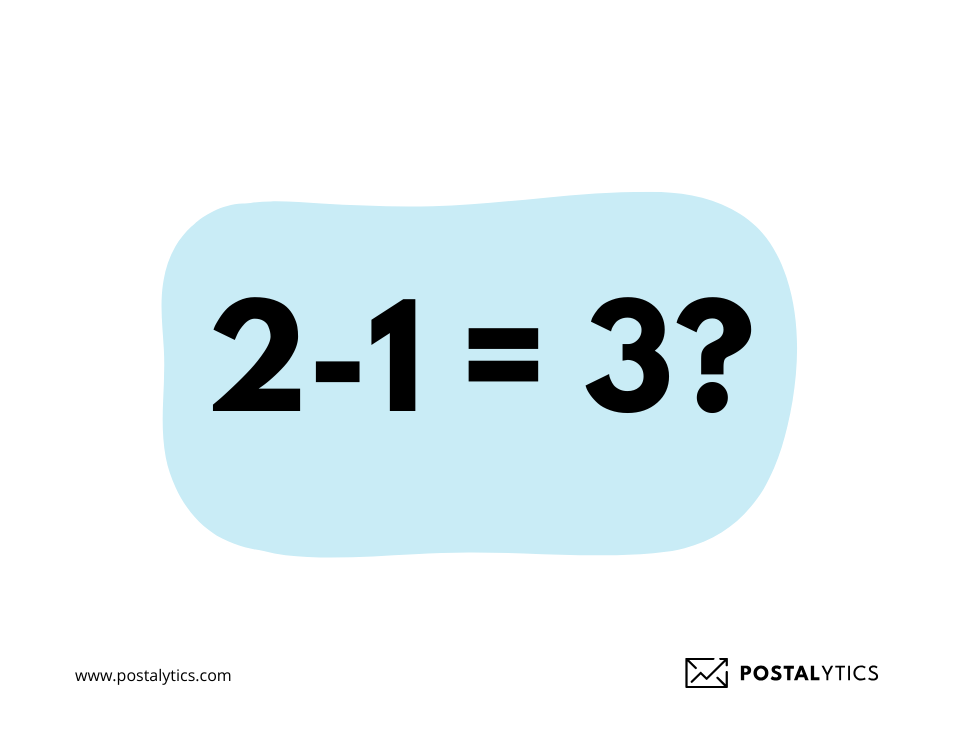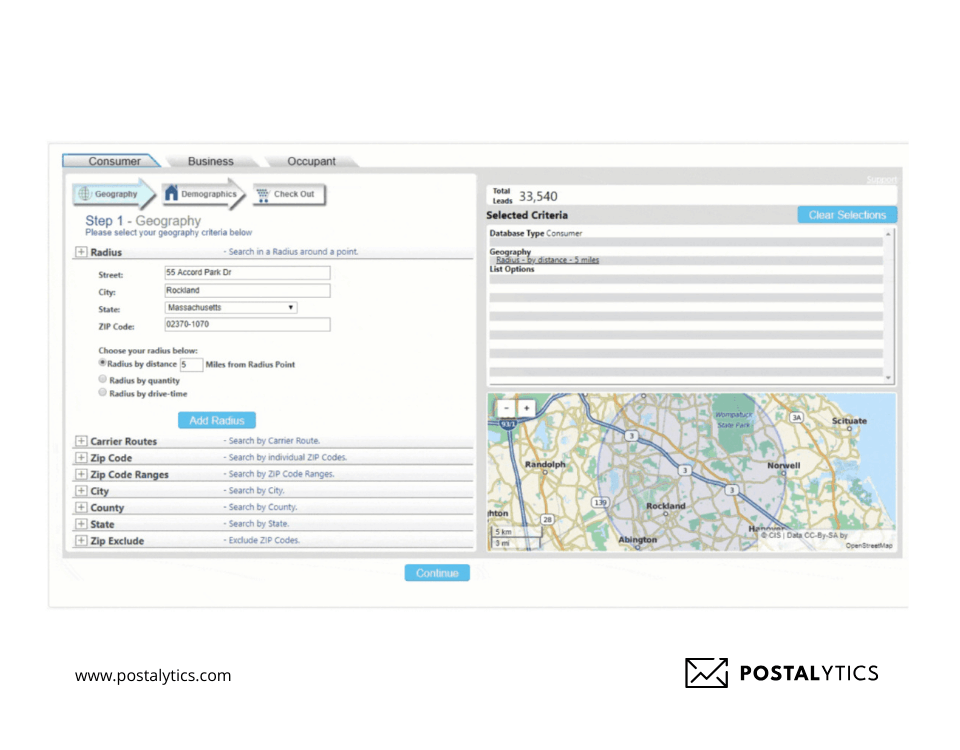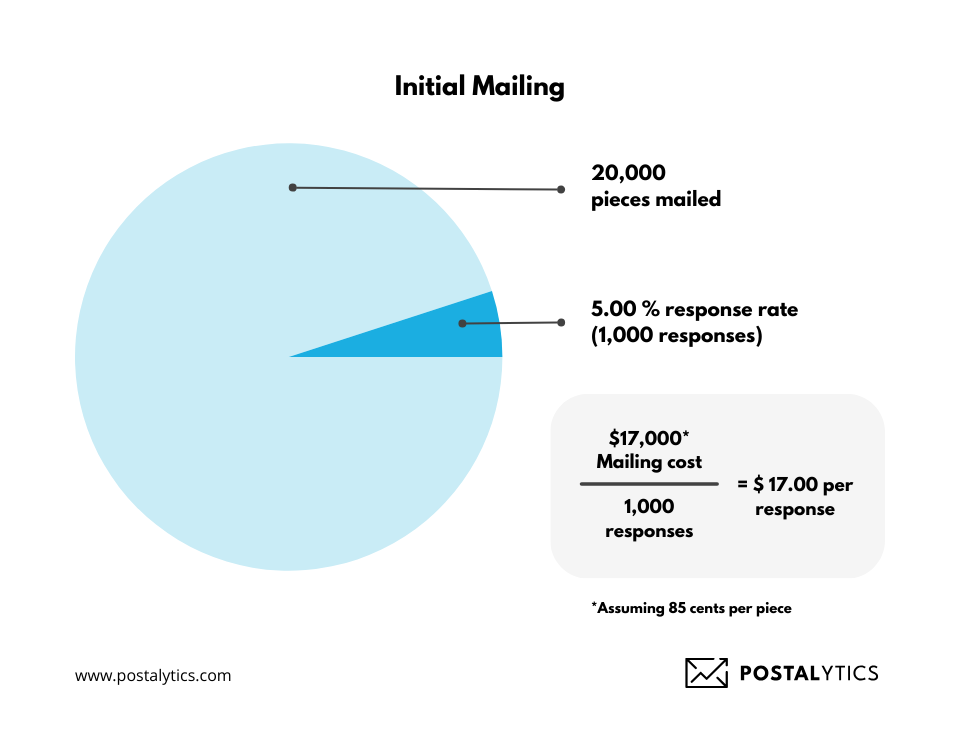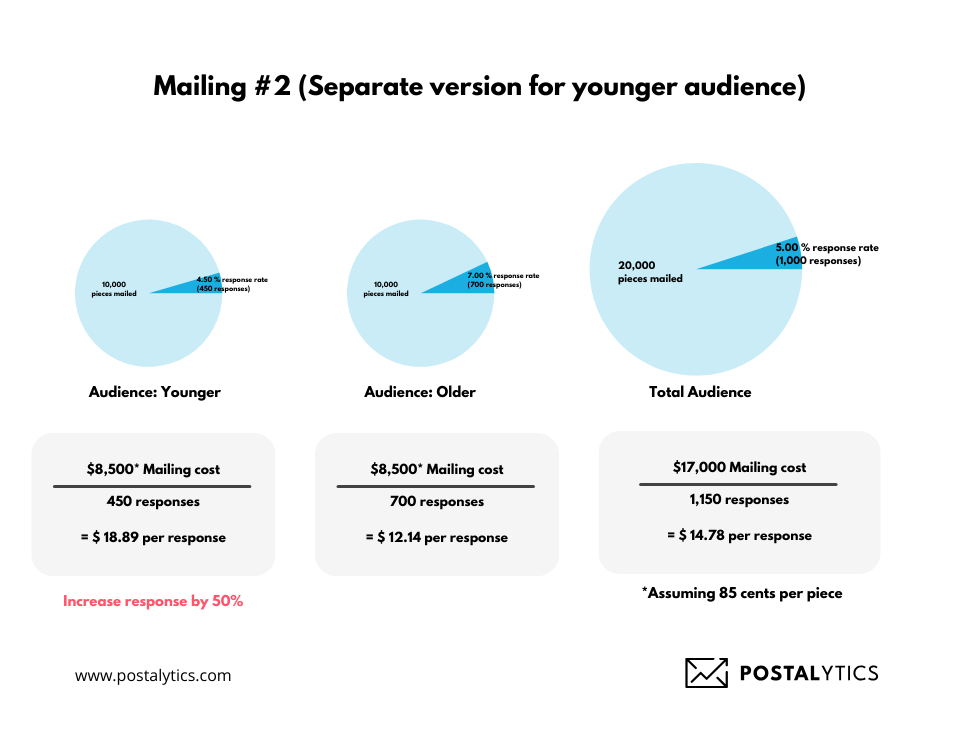
How many addresses should be on your direct mailing list to generate 1,000 responses?
Ideally, just 1,000.
Achieving a 100% response rate would make you a direct mail marketing genius—reaching the perfect audience with the right offer at the ideal moment.
While that goal is unrealistic, it highlights how choosing the right mailing list significantly impacts response rates and direct mail ROI.
With consumer trust in direct mail still high, many marketers invest countless hours and resources perfecting their mailers—fine-tuning headlines, brand messaging, and imagery to maximize engagement.
But the question of who to mail it to? The address list is all too often a last-minute decision given little thought.
What We’ll Cover:
- The 40-40-20 Rule of Direct Mailing Lists
- Who Should and Shouldn’t Receive Your Mailing?
- How to Acquire Mailing Lists for Direct Mail Marketing
- Types of Direct Mailing
- 1. Your Internal Database — CRM or Marketing Automation Mailing Lists
- 2. Response Direct Mail Lists — Targeting Specific Interests and Behavior
- Industry and Role-Based Business Response Lists
- 3. Compiled Direct Mailing Lists – Best For Geographic & Demographic Targeting
- Three Types of Compiled Mailing Lists
- How to Get Mailing Addresses – Direct Mail List Purchase
- Improve Your Mailing List With Continuous Testing
- Avoid Sending to Outdated Addresses Repeatedly
- Postalytics Can Help You Get the Direct Mail List You Need
The 40-40-20 Rule of Direct Mailing Lists

Decades ago, legendary direct marketing expert Edward Mayer defined the “40-40-20 rule” for direct marketing, pointing out that successful performance is based:
- 40% on the audience
- 40% on the message and offer
- 20% on creative execution
If 40 percent of your success depends on the mailing list you select, it’s essential to do all you can to not only select the right direct mailing list, but refine it to target individual segments with more precise messaging.
Even the best of offers can perform poorly if the mailing is sent to the wrong people. Yet many marketers don’t even bother testing address lists at all. Why throw all your eggs in one basket? Given that direct mail offers an excellent testing environment, that’s a missed opportunity.
Who Should and Shouldn’t Receive Your Mailing?

Whether targeting consumers or businesses, you have thousands of excellent direct mailing lists to choose from. From lists compiled from public records to more refined lists that reflect interest and purchase behavior, marketers have access to a wide variety of services that can build highly targeted mailing lists.
Select List Attributes & Test Segments
For every mailing list there are likely specific segments that are more likely to respond than others. Because you can select many of these attributes from a mailing list, you can discover which ones perform better and target those specific segments more precisely. By eliminating segments that don’t perform as well, you can reduce your overall costs and decrease your cost per response.
Addition By Subtraction

You want to mail to the right people — whether to make a sale, offer a discount, generate leads for further follow-up, or meet another marketing objective — but avoiding mailing to the wrong audience is equally important. That could be a disaster. For example:
- A plumbing company may have a great reputation for excellent service at a reasonable cost, but if they mail to renters, they’re reaching the wrong people.
- An office cleaning company may enjoy a similar reputation but won’t generate much response if the company is sending mail to homeowners.
- Investment or financial advisor-seeking leads won’t find much success in non-affluent areas.
Business Mailing Lists
And for business-to-business marketing, you don’t only need to reach the right business but the right role within that business at the right level of decision-making authority. This makes the selection of a business mailing list that much more important.
Even if a company desperately needs a new accounting system, a direct mail package needs to get the Chief Financial Officer (maybe even the CEO) — not to the marketing or human resources department. Your business mailing list needs to be targeted enough to get your message to the right people.
Learn how to nurture B2B leads with direct mail.
How to Acquire Mailing Lists for Direct Mail Marketing

Postalytics has integrated direct mail list purchasing into its app, allowing users to purchase and download high-quality mailing lists for US addresses without leaving the platform.
This new feature is focused on solving problems with legacy direct mail marketing by making it faster and easier for marketers to select and obtain mailing lists.
The direct mail lists are compiled from multiple sources and are refreshed every 30 days to ensure the best data quality. By accessing the mailing lists directly in Postalytics, marketers no longer need to deal with list brokers and can ensure a high ROI.
The lists are sourced from premium providers at wholesale pricing and are available in three formats: consumer, occupant, and B2B business. The platform also offers a low-cost “Occupant” list option, and micro-targeting is possible with lists as small as 20 records.
Get a free account to acquire your mailing list today.
Types of Direct Mailing
What are the primary types of direct mailing lists?
1.) Internal database/CRM Lists
2.) Response Lists
3.) Compiled Lists
Most direct mail address lists fall into one of these major categories. They vary significantly in the ways they are sourced, how they are used and how much they cost. Let’s explore each of them.
1. Your Internal Database — CRM or Marketing Automation Mailing Lists

There are certainly many outside mailing lists to choose from, but your best list is almost certainly your own internal database – as long as it is up to date.
There are three reasons why internal or “house” direct mailing lists perform best:
- The people on this list know you. After all, they’ve inquired about your services, responded to other offers from you, received a free trial, attended a specific trade show and more.
- It’s free. Yes, you’ve spent a lot of resources building your database, but using to precisely target key audience segments is where that effort really pays off.
- More segmentation opportunities. Your database contains more attributes that can be used to segment mailings. For lead generation applications, for example, you know where each target stands in their decision-making process.
Most internal address lists are generated in a software tool, such as a CRM, Marketing Automation, Point of Sale or Email Marketing system. Often they are exported into spreadsheets – which can cause problems with zip codes! Postalytics has created several ways to import internal lists directly via API integrations, as well as an easy way to import spreadsheets that will fix many improper zip codes.
Pro Tip: Learn How To Import Lists From Your CRM or Marketing Automation
Leverage Your Database for Automated Direct Mail Campaigns
Even better, you can easily set up automated mailings based on events and other attributes that you define in your CRM or Marketing Automation tools.
If a customer just bought product A, they may be an excellent candidate to buy product B. Or if someone just inquired about a specific topic, you can customize your mailing to that topic. For example, if your company sells landscaping services, you might send a mailing to someone who inquired about a specific one-time project. But that mailing might be different if the inquiry was about ongoing maintenance.
Learn How To Use Direct Mail To Nurture B2B Leads
To make most effective use of your internal marketing database, be sure you keep it up to date and track as many attributes as you can. The more data you track, the more you can personalize your mailing through automation.
2. Response Direct Mail Lists — Targeting Specific Interests and Behavior

A “response list” is a direct mailing list of those who have responded to other company’s offers, belong to specific organizations, have purchased goods and services similar to yours from other companies, or have indicated special interests and attributes in other ways.
For consumers, response lists often take the form of subscribers to publications, members of organizations, or customers of other companies. These address lists are often available to rent as long as your offer doesn’t directly compete with the list owner’s business.
Examples of response lists can include:
- Members of organizations such as AARP or AAA
- Subscribers to publications, such as The Wall Street Journal, hobbyist publications and other special interest periodicals
- Customers of companies such as Harry and David or L.L. Bean
(Note that these are hypothetical examples, as these lists may not be available)
Industry and Role-Based Business Response Lists
For B2B use, business direct mailing lists can be selected vertically based on industry sector or horizontally based on role within a business. For example, non-profit marketers would likely find good prospects from an “Affluent Donors List” of people who’ve donated large sums in the past. Or The Chronicle of Higher Education could be a good choice if you’re marketing to college executives.
In other cases, especially if your offer is appropriate across multiple industries, a more horizontal approach may be more effective. Mailing to subscribers of CFO Magazine might be a good choice for promoting financial solutions to businesses. Or using a list of American Marketing Association members could be a great audience for marketing software and solutions. The same holds true for other roles, including supply chain management, human resources, and many more.
3. Compiled Direct Mailing Lists – Best For Geographic & Demographic Targeting

Compiled direct mail lists are built from proprietary and publicly available data sources about individuals, households, and businesses. They’re typically less expensive than response lists and are often used in direct mail campaigns that require geographic targeting and/or demographic (or the business equivalent – firmographic) data to zero in on the best prospects.
Where does compiled list data come from? Typically, multiple sources are used to create and refresh these targeted mailing lists, including:
- Telephone directories
- Government records such as voter registration, deed, and other property data, business incorporation, court records & more
- Private data sources such as credit card companies, survey responses, etc.
Local Service Providers Often Use Compiled Mailing Lists
Compiled direct mailing lists are often a go-to source of leads for local service providers such as dentist offices, car dealer & repair shops, restaurants, banks, insurance agencies, IT support companies, and others.
Typically, these direct mail campaigns are focused on very specific geographic segments. Compiled targeted mailing lists can zero in on specific towns, zip codes, or even small radii around an address. They can then be further defined by demographic or firmographic selections such as income level/business revenue, home ownership, marital status, number of employees, and more.
Want to try out a compiled list? We can connect you with the best list brokers in the business to get high-quality mailing lists at competitive prices.
Get A Free Postalytics Account
Three Types of Compiled Mailing Lists
Most compiled direct mailing lists fall into 3 categories – consumer, occupant, and business lists.
Consumer Direct Mailing Lists

Compiled mailing lists of people include not only names and addresses, but are often appended with data that makes it easy to select by age, gender, educational background, family size, and other factors. In some cases, data is used to estimate income, wealth and other attributes for specific consumers.
Learn How To Find The Best Consumer Mailing Lists!
Consumer address lists are valuable because you can reach everyone in a specific area, whether by state, city or town, Zip Code or even smaller regions that represent postal carrier routes.
If you don’t need highly specific purchase behavior segmentation, these mailing lists offer more value because they’re a lot less expensive than lists sold through mailing list brokers.
If, for example, your company offers tutoring for K-12 students, you can select a targeted mailing list for a specific location and select consumers with children in that age range. Or if you’re an auto dealer selling luxury cars, you can select consumers in a local area that live in more affluent areas.
Households (or occupants)

In some cases, you may not even rent names of people at all, but mail to specific households (using “Resident” or another designation to replace the name on your mailer).
Occupant Lists are often among the least expensive lists you can acquire, as they offer minimal demographic selection criteria.
This offers you the opportunity to saturate specific geographical areas. Indeed, people tend to live among others who share similar characteristics, so a set of Zip Codes, towns or even specific postal routes may be of special interest.
Restaurants use these types of mailing lists frequently because they want wide saturation to promote a grand opening, offer a holiday special, etc. Other retail businesses – dry cleaners, auto repair shops and local grocery stores to name a few – use these mailing lists in a similar manner because they’re inexpensive and convenient when selected within the Postalytics platform while preparing a mailing.
Compiled Business Mailing Lists

When you need a targeted mailing list for businesses, a compiled list can be your best choice — especially if industry sector and business size are important or you want to confine your mailing to a specific geographic area.
Compiled business lists are segmented by a wide variety of other attributes, including company size, length of time in business and other criteria.
In some cases, only the business name is available, not the names of specific executives in a business. You can, however, create a role-based title to replace the name on your mailer. For example, you could address a mailing piece to “Human Resources Manager” if that role is most suitable. Or for smaller organizations, a “Chief Executive Officer” title might be fine.
How to Get Mailing Addresses – Direct Mail List Purchase
There are several types of companies that can provide high-quality direct mailing lists. Pricing can vary significantly based on a variety of factors, including the level of customization, minimum spending, and more.
Depending upon how customized they are and their desirability, address lists can have wide variations in pricing and sources.
Renting a mailing list is the most common way to acquire a list. You don’t purchase the list outright. Instead you get either one-time access or unlimited access over a specified time period. Many mailing list services offer rental as their only option.
Buying a mailing list is requires an up front investment, and it’s worth every penny. The advantage is that you can use the list on an unlimited basis. The benefits multiply if the audience you need to reach is relatively static, such as a small, industry-specific B2B list. You can order your niche-specific list through Postalytics. Read more about buying lists for direct mail here.
Compilers vs. Brokers
Traditionally, direct mailers rented or bought lists from either “compilers” or “brokers”.
Compilers build the actual databases that direct mailing lists are pulled from and often employ commissioned salespeople to distribute them to clients.
On the other hand, brokers are typically independent representatives who can help you acquire lists from various sources.
Some of the most well-known targeted mailing list compilers and brokers include:
Mailing List Rental Pricing
Prices for targeted mailing lists can vary. Response lists are generally more expensive than compiled lists because they are usually more targeted.
Mailing address lists are commonly priced out on a per-record basis and often include minimum orders (especially when using a list broker – the deal needs to be worth their time). In addition to “base pricing,” there can be “premium selects and outputs” that can tack on additional per-record fees.
Read more about acquiring an integrated list for direct mail through Postalytics here.
Improve Your Mailing List With Continuous Testing
Selecting a targeted mailing list isn’t a one-time decision. It’s an ongoing process of testing various segments, and adapting creative to connect with those segments. Let’s say you send a 20,000-piece campaign at a cost of $17,000 and get 1,000 responses (5% rate):

You may be pleased with a cost per response of $17.
But if you analyzed your mailing by segment, you might notice different response rates between segments. For example, taking a look at two age groups — each representing half of your mailing — might reveal your mailing did well with older people but not so well with younger people:

Here, you can see that while your overall response was 5 percent, it was much lower with younger people. And while your cost per response was $17, that cost was only about $12 for the older audience but more than $28 for younger people.
For future mailings, you could target an older audience and avoid mailing to younger people. That would reduce your overall cost and your cost per response.
But let’s say that you develop a creative execution that’s more customized to a younger audience. Perhaps you could boost the response rate by 50% in this group:

Now you’ve reduced your cost per response for younger people and overall CPR — from $17 to $14.78 (a 13% percent improvement!)
Selecting your targeted mailing list represents a key decision that impacts the success of your campaign. And by testing various list segments, you can lower costs and boost response.
Avoid Sending to Outdated Addresses Repeatedly

Even targeted mailing lists rarely offer 100 percent deliverability because people and businesses constantly move – roughly 9.8% of Americans move in any given year.
What can you do about old, no longer valid addresses? You can start by keeping your list updated. Each time you get a returned mailer, you should remove the contact from your list.
Get A List of Your Returned To Sender Mailers
Direct mail automation tools handle this for you. Postalytics taps into the USPS Intelligent Mail Barcode system to automatically update your direct mailing lists. Each time your direct mail campaign receives a “Return To Sender” or “Re-routed” scan, the corresponding contact in your list is marked as “Invalid”. This means it won’t be mailed to this recipient again.
What does this mean? For a multiple-touch direct mail campaign the best performing type of direct mail campaign), your deliverability will improve with each mailing.
Postalytics Can Help You Get the Direct Mail List You Need
As you can see, there are many ways to tailor a direct mailing list to best suit your needs. If you have any questions about selecting or acquiring a mailing list for your next direct mail campaign:
About the Author

Dennis Kelly
Dennis Kelly is CEO and co-founder of Postalytics, the leading direct mail automation platform for marketers to build, deploy and manage direct mail marketing campaigns. Postalytics is Dennis’ 6th startup. He has been involved in starting and growing early-stage technology ventures for over 30 years and has held senior management roles at a diverse set of large technology firms including Computer Associates, Palm Inc. and Achieve Healthcare Information Systems.
